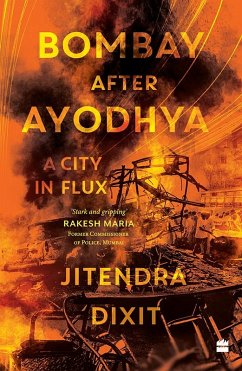The demolition of the Babri Masjid in Ayodhya on 6 December 1992 was followed by riots across India. Mumbai had always been susceptible to communal violence, but the violence in December 1992 and then again in January 1993 was unprecedented. Two months later, in March, serial blasts rocked the city, killing over 250 and injuring 700. Communal strife was followed by gang wars and natural calamities, all of which changed the city forever.
Bombay after Ayodhya chronicles how the past three decades have been a period of unprecedented flux in Mumbai. In the aftermath of the riots, a split in the Mumbai underworld led to new equations in politics, which changed the demography of the city and led to the rise of new townships. After a brief lull, blasts and terrorist attacks rocked it once more in 2002, a cycle of violence that culminated in the horrific 26/11 attacks in 2008.
Jitendra Dixit grew up in Mumbai and has reported from the city for much of the three decades he writes about in this book. This is a deeply felt biography of a city, which has transformed from a city of mills to one of malls, where the number of skyscrapers has multiplied along with their height, where local trains have become longer and yet remained overcrowded. It is the city of Bollywood, yet constraints of producing films in the city have led filmmakers to move out. Its iconic festivals, such as Ganesh Utsav and Govinda, once primarily celebrated by the poor and the middle class, have become commercialized.
Along with key events and people that have shaped the evolution of present-day Mumbai, Bombay after Ayodhya also documents the change in the city's character, from its physical appearance and civic issues, to real estate and politics.
Bombay after Ayodhya chronicles how the past three decades have been a period of unprecedented flux in Mumbai. In the aftermath of the riots, a split in the Mumbai underworld led to new equations in politics, which changed the demography of the city and led to the rise of new townships. After a brief lull, blasts and terrorist attacks rocked it once more in 2002, a cycle of violence that culminated in the horrific 26/11 attacks in 2008.
Jitendra Dixit grew up in Mumbai and has reported from the city for much of the three decades he writes about in this book. This is a deeply felt biography of a city, which has transformed from a city of mills to one of malls, where the number of skyscrapers has multiplied along with their height, where local trains have become longer and yet remained overcrowded. It is the city of Bollywood, yet constraints of producing films in the city have led filmmakers to move out. Its iconic festivals, such as Ganesh Utsav and Govinda, once primarily celebrated by the poor and the middle class, have become commercialized.
Along with key events and people that have shaped the evolution of present-day Mumbai, Bombay after Ayodhya also documents the change in the city's character, from its physical appearance and civic issues, to real estate and politics.
Dieser Download kann aus rechtlichen Gründen nur mit Rechnungsadresse in A, D, L ausgeliefert werden.


